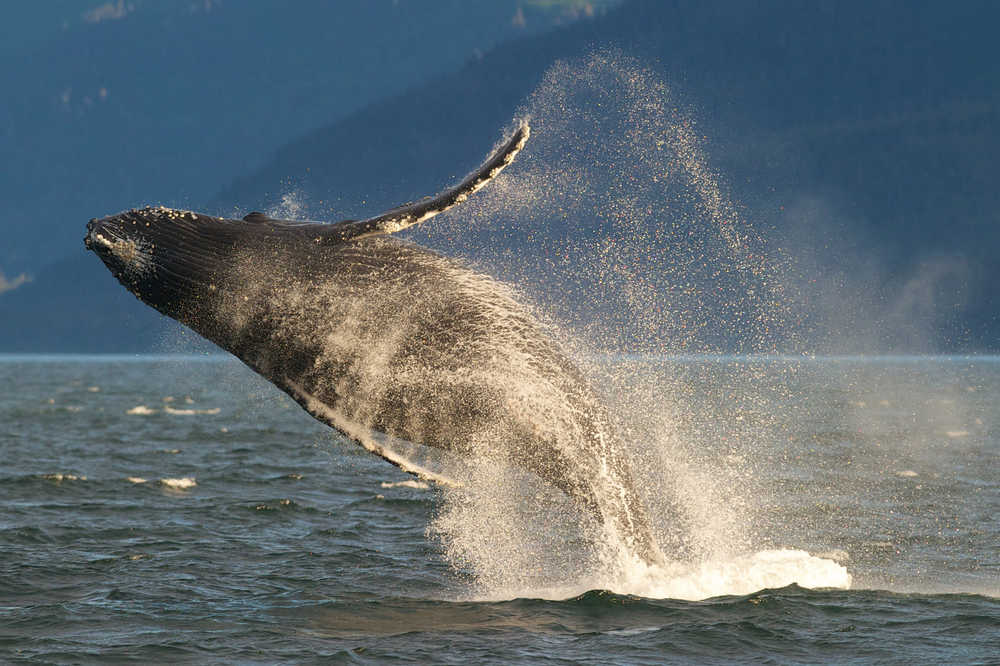A group of humpback whales found in Southeast Alaska has recovered enough to no longer warrant listing under the Endangered Species Act, while another group has been down-listed as threatened, the National Oceanic and Atmospheric Administration announced Tuesday.
“It’s a good sign in the sense that humpback whales are recovering, and that’s no surprise to people who live in Southeast who have been seeing more humpbacks than we’ve seen before in recent times,” Jon Kurland, the Juneau-based assistant Alaska region administrator for protected resources, said in a phone interview Tuesday.
In the past, commercial whaling severely reduced humpback whale numbers from historical levels, and the United States listed all humpback whales as endangered in 1970.
In order to determine that some humpback whales found in Southeast are no longer endangered, NOAA split the species into 14 newly identified distinct population segments. Nine of them no longer warrant listing under the Endangered Species Act, four remain protected as endangered and one is now listed as threatened.
Three distinct population segments, or DPSs, are found in Alaska waters.
“The one that is most common in Southeast Alaska is the Hawaii DPS, and that population will not be listed as either threatened or endangered. There is a Mexico DPS that will be listed as threatened, and those do occur in SE in small numbers. And then there is also a Western North Pacific DPS, which will be listed as endangered. Those have not been seen in Southeast, but they have been found elsewhere in Alaska,” Kurland said.
Although down-listed to threatened, the Mexico group will remain under the protection of the Endangered Species Act.
“Threatened means that they may become endangered within the foreseeable future,” Kurland said. “For a recovering population, it’s kind of an intermediate stop. It’s not yet ready for being removed from the list of threatened of endangered wildlife.”
All humpback whales, regardless of status on the endangered species list, are still protected under the Marine Mammal Protection Act.
“That means that any ‘take’ of a humpback — anything that harasses the animal or causes injury to the animal or, certainly, that kills an animal — that’s still prohibited by federal law. It’s an added layer of protection that marine mammals have,” Kurland explained.
[PHOTOS: Humpback whales in Juneau waters]
NOAA’s hundred-yard rule for humpback whales also remains in place in Alaska waters. It stipulates that it’s unlawful to approach within 100 yards of a humpback.
Kurland said most people in Alaska won’t see a practical difference in NOAA’s decision to delist one group of humpback whales in Alaska.
“From a management standpoint, it enables us to focus more on those populations that are still really in trouble, like the Western North Pacific population, and try to promote their recovery. Although not too many of them occur in Alaska, we would be more concerned about impacts to animals from that population than we would be for the Hawaii DPS because Hawaii is further along in their recovery,” he said.
Population and threats
Determining that nine groups of humpback whales no longer warrant the protection of the Endangered Species Act was based on extensive scientific review and public comment, said Angela Somma, chief of NOAA Fisheries’ endangered species division.
[Fishermen want humpback whales off endangered list]
“Their population abundance numbers have risen to a level where they no longer meet the definition of a threatened or endangered species, coupled with the threats being largely ameliorated and not at a level that’s posing a risk to their extinction,” Somma said Tuesday during a press conference in Silver Spring, Maryland, where NOAA Fisheries is headquartered.
Somma said most populations have increased substantially from where they were when populations were depleted from commercial whaling, although she couldn’t supply an estimate of humpback whales in 1970 when they were listed as endangered.
NOAA estimates the Hawaii group, which breed in Hawaii and feed in Alaska, at 11,398 animals. Marta Nammack, NOAA Fisheries’ national Endangered Species Act listing coordinator, said the DPS continues to increase at a rate of 5.5 to 6 percent. These humpbacks face a moderate threat of fishing gear entanglements.
The estimated abundance for the Mexico group is 3,264. These animals continue to face a threat of vessel collisions and gear entanglements. “Due to the uncertainty about population trend, we decided to list it as threatened,” Nammack said.
The Western North Pacific group, which breeds in Okinawa, Japan, and the Philippines, and feeds in the Bering Sea and Aleutian Islands is estimated at 1,059. NOAA still considers this group endangered. Continued threats to this group include energy exploration, development, vessel collision, fishing gear entanglement and “suspected illegal or unreported” whaling, Nammack said.
NOAA will continue to monitor humpback whale populations no longer on the endangered species list for 10 years to assess their status.
• Contact reporter Lisa Phu at 523-2246 or lisa.phu@juneauempire.com.
Read more news:
It’s Miller v. Murkowski – again
State certifies primary election results, but recount is imminent

